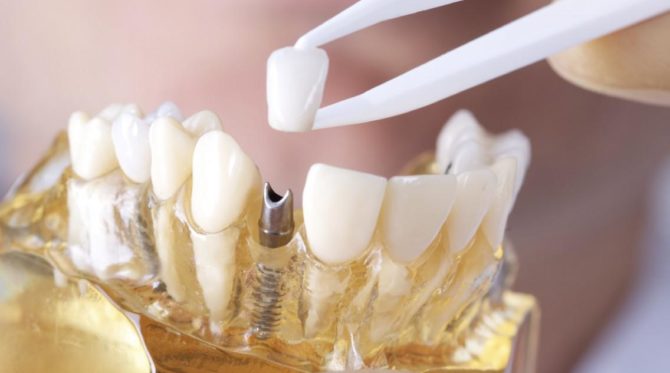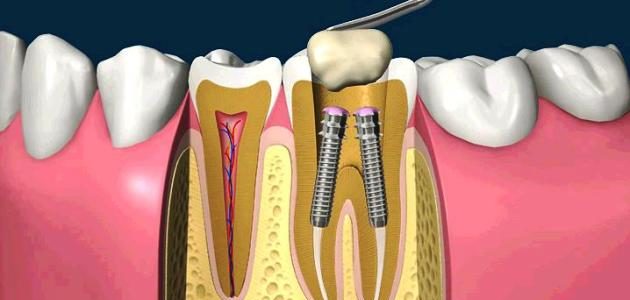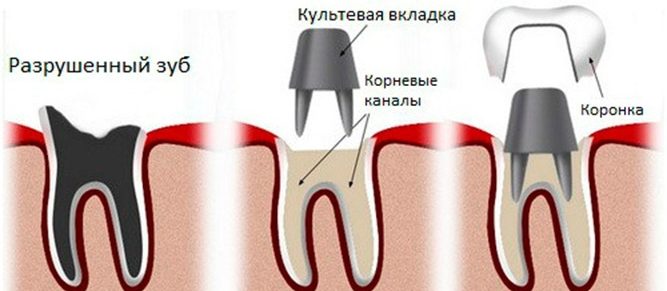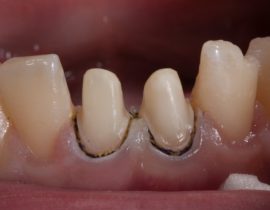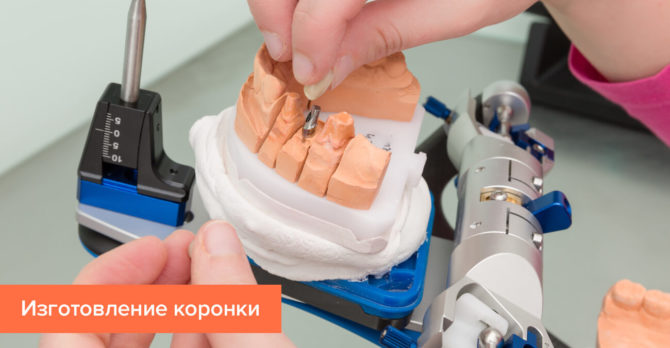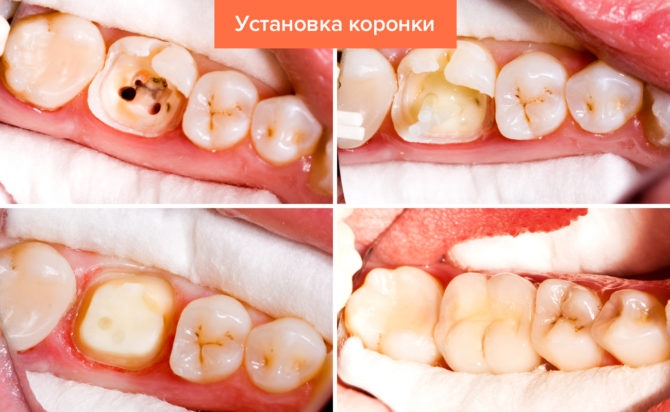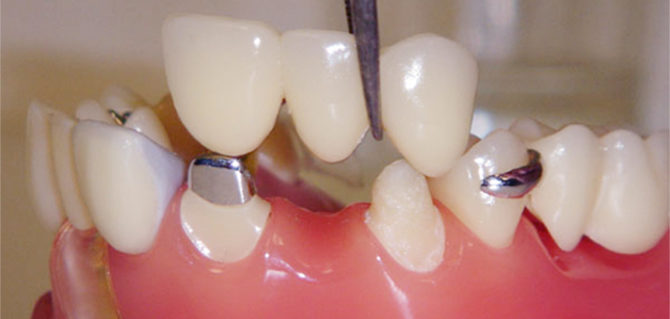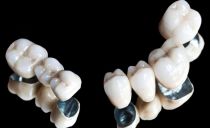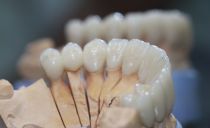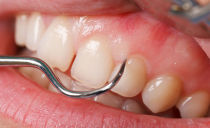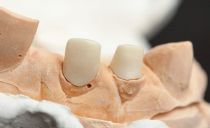How to put a crown on a tooth: stages and installation process, tooth preparation, does it hurt to put
Dental prosthetics with crowns is a responsible process, since in addition to the aesthetic attractiveness of a smile, the chewing functions of the teeth are restored due to the crowns. Putting a crown on a tooth is not painful, but this procedure lasts for several weeks, or even months - most of the time is spent on the manufacture of the prosthesis. In addition, the result obtained depends on many factors, the main one is the competence of a specialist. Therefore, everyone who decides to install crowns should know how the basic stages of prosthetics are performed.
Content
Primary appointment in dentistry
The crown is not immediately placed on the tooth; first, it is necessary to go through several preparatory stages. One of them is an initial examination and consultation with a dentist. During the first appointment, the doctor examines the oral cavity, identifies problem teeth, and collects an anamnesis. Then, an x-ray examination is prescribed, with the help of which pathologies of the dental tissue, inflammatory processes in supporting units are revealed.
The specialist finds out the presence of factors that can affect the installation of the crown on the tooth or become a contraindication to prosthetics:
- an allergic reaction to certain drugs or materials;
- pregnancy;
- tumor neoplasms;
- chronic pathologies;
- diseases of the internal organs;
- CNS disorder.
Based on the wishes of the patient and the compiled clinical picture, the doctor determines the treatment plan. Before prosthetics, extraction of dental units without nerves ("dead") is performed. Gradually collapsing, they contribute to the development of various disorders that adversely affect the condition of crowns and shorten their operational life. In addition, medical procedures are carried out, during which inflammatory processes that affect bone or gum tissue are eliminated.
At the same stage, a detailed consultation of the patient and coordination of the type of dental structures is carried out. The doctor selects the best option for prosthetics, taking into account the physiological characteristics of a particular patient, explaining his choice, agreeing on the cost.
Depending on the clinical case and the financial capabilities of the patient, the installation of a crown made of cermet, plastic, and ceramic may be recommended. The most inexpensive, but also short-lived, are plastic and ceramic products. In most cases, dentists recommend a cermet, due to:
- High rate of wear resistance.
- Creating an aesthetic appeal that does not change over time.
- Features of the construct. Dental technicians make the frame of a ceramic-metal crown on a tooth from an alloy of medical or pure precious metals (gold).
- The ceramic-metal product has high hypoallergenic properties and biocompatibility with body tissues.
- Reasonable cost.
You can see how the teeth look before and after the installation of cermet, in the photo:
Preparation of the tooth for the crown, installation steps
The stage of prosthetics, preceding the installation of the crown on the tooth, requires special professionalism. Often, preparation begins with the removal of a nerve in a problematic dental unit. Indications for depulpation are:
- advanced caries;
- wrong position;
- decay of one or more roots;
- anatomical features of the dental unit;
- inflammation of the periodontal pulp.
Depilation is always performed when you need to put a crown on a single-root front tooth. Such an operation is necessary, since in the process of grinding a tooth in the shape of a crown, a doctor can burn the pulp. Units with several roots do not require removal of the nerve, since the likelihood of a burn of the pulp during grinding is minimal.
At the preparatory stage of prosthetics, medical procedures are carried out, canals are sealed, professional cleaning of dental units from plaque and hard deposits is performed. By the time of grinding and installation of prostheses, the teeth should be healthy and clean, the presence of foci of inflammation in the oral cavity, irritation of the gum tissue is not allowed.
If the supporting unit is severely damaged, then after removing the nerve and filling the canals, the dentist restores the crown part using a special material. This is necessary to create the necessary foundation for successful prosthetics.
Crown restoration
Preparation for prosthetics includes restoration of the crown part, this procedure is necessary to create the basis on which the tooth crown will be attached. Significant destruction of bone tissue while maintaining the root requires the installation of a pin or stump tab.
A pin is needed when hard tooth tissue is damaged by more than 50%. The process of its installation is as follows: a strong rod is screwed into the root canal, and filling material is applied to the rod, recreating the necessary basis for fixing the crown. After building artificial tissue, it is grinded under the prosthesis.
A stump insert is inserted into the completely destroyed tooth, due to which it becomes possible to install an artificial crown on the saved tooth root. The stump tab is a mount that is made of hypoallergenic and biocompatible metal. The design is inserted into the dental canal and fixed with a special cement mortar, and then the walls of the canal and the crown part are extended to fix the prosthesis.
Grinding
Preparing a tooth for a crown involves grinding it. The preparation of the tooth consists in removing the upper layer of hard tissue, the thickness of which depends on the crown installed and varies from 1.5 to 2 mm. The specialist grinds hard tissues to obtain a base or “stump”, on which a crown is mounted in the future. The resulting base is used to make an impression on which the future prosthesis is made.
The grinding process is necessary to give the problematic dental unit the desired shape for subsequent prosthetics. To grind a tooth, a drill or diamond bur is used.
The grinding process is painless, but uncomfortable. Painlessness is achieved with local painkillers. Unpleasant and uncomfortable sensations arise only when processing dental units with nerves, giving the necessary shape to “dead” teeth occurs without pain, painkillers in this case may not be used.
During the procedure, a “stump” is formed from a turned tooth, according to which a cast is made to make a prosthesis. The resulting crown is placed on prepared teeth.
Laboratory stage
A tooth crown is made in a special laboratory in the following order:
- First, make the frame basis of the structure.The frame can be made of medical alloys with high wear resistance and durability, or compounds of precious metals (platinum, gold), which are hypoallergenic and biocompatible with body tissues.
- The next step involves layer-by-layer application of a ceramic coating to the frame base. The ceramic mass is applied in the form of an impression taken from a turned base or restored crown part. This method of application ensures maximum compliance with the product "cult", the exact fit of the fixed crown.
- The manufactured prosthesis is subjected to special processing - it is fired in an oven at temperatures up to 900 degrees. This manufacturing stage provides quick adhesion and pronounced interaction of the prosthesis components, due to which its high strength and resistance to external negative influences are achieved.
For the manufacture of a permanent crown, time is required, therefore, for this period, the patient is given temporary prostheses made of durable plastic.
How crowns are made is shown in the video:
Fitting and fixing crowns
Before installing a permanent denture on the teeth, it is necessary to carry out a number of mandatory manipulations:
- A fitting, which must be prescribed during the manufacture of a permanent crown. The procedure is carried out to assess the compliance of the frame base with the necessary parameters, the accuracy of its landing on a turned stump. In some cases, necessary adjustments are made.
- Temporary installation of a permanent prosthesis. The crown is placed on a prepared base and fixed with temporary cement. The procedure is necessary to get used to the prosthesis, to identify a comfortable or uncomfortable state when wearing. Temporary models make it possible to determine the presence of inflammatory processes, to identify violations committed during treatment and filling the canals. In the process of wearing a temporary prosthesis, common defects can be revealed: loose crown fit, oversized bite.
- The final fixation of the crown. The period of wearing temporary prostheses is from 2 weeks to 1 month. In the absence of complaints, the specialist removes the dentures and cleans the base from temporary cement. After removal, the crowns are inserted back onto the teeth and fixed with permanent cement.
Indications and contraindications
Specialists put a crown on a tooth in certain cases:
- One of the common conditions for prosthetics is severe tooth decay, when bone tissue is destroyed by more than 50%. In such a situation, the masticatory load is distributed unevenly, which can lead to damage to the tooth base. And filling and restoration are ineffective. The crown protects the tooth, minimizes the risk of further destruction, and returns the necessary functions.
- Congenital pathologies and hereditary abnormalities. There are a number of pathologies that cannot be fixed with braces or other correction systems.
- The absence of one, two or more teeth. In the latter case, a bridge is installed, which is attached to the remaining healthy teeth - supports for the prosthetic structure.
- The presence of diseases that provoke accelerated abrasion of enamel. In this case, the crown is the best option for protecting the tooth from external negative factors, it is able to maintain its viability for a long time.
- Pronounced color change of enamel. The installation of crowns allows you to restore the natural color of the teeth.
- Abnormal placement, pronounced refinement and curvature. The prosthesis allows you to restore not only the lost attractiveness, but also the normal functioning of the dental units.
- The installation of prostheses helps to fix mobile teeth (splinting procedure), which is necessary to preserve them.
There are a number of contraindications in which prosthetics is excluded.
- Dentures are not installed for pregnant women.
- Prosthetics are contraindicated in severe forms of periodontal disease, the presence of foci of inflammation and infection in the oral cavity.
Important contraindications to the installation of crowns are psychopathology, disorders of the central nervous system, the presence of tumor neoplasms, infectious diseases (ARI, SARS).
Does it hurt to put a crown on a tooth
Putting crowns is not painful, the process can be accompanied by only slight discomfort. However, the preparatory stage of the installation of crowns can be painful, because during this period the teeth are drilled, the root canals are cleaned and sealed, and hard tissues are honed.
Prosthetics of “dead” teeth are imperceptible, since such dental units do not have nerves that respond to external influences. When crowns are worn on live teeth, a high-quality analgesic is used that completely blocks the pain syndrome both at the preparation stage and in the process of prosthetics.
How long does the installation of crowns
Crown prosthetics are not done in 1 day, because they include several mandatory steps. The terms for the phased installation of prostheses reach 1-2 months. The longest stage is the period of manufacture of dental crowns.
Dental prosthetics is the optimal solution not only to aesthetic problems. Crowns are installed in order to restore integrity and necessary functionality to the teeth. Modern technologies used in dental prosthetics make the process as painless and effective as possible.

